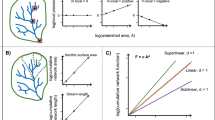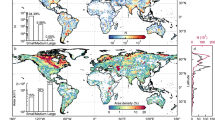Abstract
Scaling relationships, including power laws, provide quantitative predictions used in basic and applied sciences. We investigated scaling relationships between catchment area and lake surface area, the ratio of which has important implications for terrestrial-aquatic linkages. Synthesizing evidence from 9 datasets from three continents, we show that there is an approximately linear relationship between lake surface area and catchment area, and that reservoirs and other human-made lakes tend to have larger catchments than natural lakes. Using the example of DOC export from forested catchments, we illustrate how the relationships observed in this study can be used to provide first-order estimates of ecosystem processes coupling lakes and their catchments.


Similar content being viewed by others
References
Aitkenhead JA, McDowell WH (2000) Soil C: N as a predictor of annual riverine DOC flux at local and global scales. Global Biogeochem Cycles 14:127–138
Baker JP, Gherini SA, Christensen SW, Driscoll CT, Gallagher J, Munson RK, Newton RK, Reckhow KH, Shofield CL (1990) Adirondack lakes survey: an interpretive analysis of fish communities and water chemistry, 1984–87. Ray Brook, NY
Bohk C, Rau R, Cohen JE (2015) Taylor’s power law in human mortality. Demogr Res 33:589–610
Canham CD, Pace ML, Papaik MJ, Primack AGB, Roy KM, Maranger RJ, Curran RP, Spada DM (2004) A spatially explicit watershed-scale analysis of dissolved organic carbon in Adirondack lakes. Ecol Appl 14:839–885
Doak DF, Bigger D, Harding EK, Marvier MA, O’Malley RE, Thomson D (1998) The statistical inevitability of stability-diversity relationships in community ecology. Am Nat 151:264–276
Downing JA (1979) Aggregation, transformation and the design of benthos sampling programs. Can J Fish Aquat Sci 36:1454–1463
Downing JA, Prairie YT, Cole JJ, Duarte CM, Tranvik LJ, Striegl RG, McDowell WH, Kortelainen P, Caraco NF, Melack JM, Middelburg JJ (2006) The global abundance and size distribution of lakes, ponds, and impoundments. Limnol Oceanogr 51:2388–2397
Downing JA, Cole JJ, Middelburg JJ, Striegl RG, Duarte CM, Kortelainen P, Prairie YT, Laube KA (2008) Sediment organic carbon burial in agriculturally eutrophic impoundments over the last century. Global Biogeochem Cycles 22:1–10
Forsius M, Malin V, Makinen I, Kamari J, Kortelainen P, Verta M (1990) Finnish lake acidification survey: survey design and random selection of lakes. Envirometrics 1:73–88
Hallett LM, Hsu JS, Cleland EE, Collins SL, Dickson TL, Farrer EC, Gherardi LA, Gross KL, Hobbs RJ, Turnbull L, Suding KN (2014) Biotic mechanisms of community stability shift along a precipitation gradient. Ecology 95:1693–1700
Harrison JA, Maranger RJ, Alexander RB, Giblin AE, Jacinthe PA, Mayorga E, Seitzinger SP, Sobota DJ, Wollheim WM (2009) The regional and global significance of nitrogen removal in lakes and reservoirs. Biogeochemistry 93:143–157
Hayes NM, Vanni MJ (2018) Microcystin concentrations can be predicted with phytoplankton biomass and watershed morphology. Inland Waters 8:273–283
Hayes NM, Corman JR, Deemer BR, Strock KE, Razavi NR (2017) Key differences between lakes and reservoirs modify climate signals: A case for a new conceptual model. Limnology and Oceanography Letters 2:47–62
Kortelainen P (1993) Total organic carbon in Finnish lakes and its relationship to catchment characteristics. Can J Fish Aquat Sci 50:1477–1483
Kretser WA, Gallagher J, Nicholette J (1989) Adirondack lakes study 1984–87: an evaluation of fish communities and water chemistry. Ray Brook, NY
Kuznetsova A, Brockhoff PB, Christensen RHB (2017) lmerTest package: tests in linear mixed effects models. J Stat Softw 82:1–26
Lagrue C, Poulin R, Cohen JE (2015) Parasitism alters three power laws of scaling in a metazoan community: Taylor’s law, density-mass allometry, and variance-mass allometry. In: Proceedings of the National Academy of the United States of America 112.
R Core Team (2018) R: a language and environment for statistical computing. R Foundation for Statistical Computing, Vienna
Rasmussen JB, Godbout L, Schallenberg M (1989) The humic content of lake water and watershed and lake morphometry. Limnol Oceanogr 34:1336–1343
Reuman DC, Zhao L, Sheppard LW, Reid PC, Cohen JE (2017) Synchrony affects Taylor’s law in theory and data. Proc Natl Acad Sci 114:6788–6793
Robert A, Roy AG (1990) On the fractal interpretation of the mainstream length-drainage area relationship. Water Resour Res 26:839–842
Seekell DA, Pace ML (2011) Does the Pareto distribution adequately describe the size-distribution of lakes? Limnol Oceanogr 56:350–356
Shreve RL (1974) Variation of mainstream length with basin area in river networks. Water Resour Res 10:1167–1177
Sobek S, Tranvik LJ, Prairie YT, Kortelainen P, Cole JJ (2007) Patterns and regulation of dissolved organic carbon: An analysis of 7,500 widely distributed lakes. Limnol Oceanogr 52:1208–1219
Taylor LR (1961) Aggregation, variance and the mean. Nature 189:732–735
Taylor RAJ (2018) Spatial distribution, sampling efficiency and Taylor’s power law. Ecol Entomol 43:215–225
Thornton KW, Kennedy RH, Carroll JH, Walker WW, Gunkel RC, Ashby S (1980) Reservoir sedimentation and water quality-an heuristic model In: Stefan HG (ed) Proceedings of the symposium on surface water impoundments. American Society of Civil Engineering pp 654–661
Tippett MK, Cohen JE (2016) Tornado outbreak variability follows Taylor’s power law of fluctuation scaling and increases dramatically with severity. Nature Communications 7:1–7
U.S. Environmental Protection Agency (2016) National Aquatic Resource Surveys. https://www.epa.gov/national-aquatic-resource-surveys/data-national-aquatic-resource-surveys.
Xenopoulos MA, Lodge DM, Frentress J, Kreps TA, Bridgham SD, Grossman E, Jackson CJ (2013) Regional comparisons of watershed determinants of dissolved organic carbon in temperate lakes from the Upper Great Lakes region and selected regions globally. Limnol Oceanogr 48:2321–2334
Xiong C, Hoyer MV (2019) Influence of land use and rainfall variability on nutrient concentrations in Florida Lakes. Lake and Reservoir Management 35:25–37
Xu M, Schuster WSF, Cohen JE (2014) Robustness of Taylor’s law under spatial hierarchical groupings of forest tree samples. Popul Ecol 57:93–103
Zhao L, Sheppard LW, Reid PC, Walter JA, Reuman DC (2019) Proximate determinants of Taylor’s law slopes. J Anim Ecol 88:484–494
Acknowledgements
This work was supported by NSF Grants OAC-1839024 and OAC-1839011. JAW was also supported by a NatureNet Science Fellowship.
Author information
Authors and Affiliations
Corresponding author
Additional information
Publisher's Note
Springer Nature remains neutral with regard to jurisdictional claims in published maps and institutional affiliations.
Rights and permissions
About this article
Cite this article
Walter, J.A., Fleck, R., Pace, M.L. et al. Scaling relationships between lake surface area and catchment area. Aquat Sci 82, 47 (2020). https://doi.org/10.1007/s00027-020-00726-y
Received:
Accepted:
Published:
DOI: https://doi.org/10.1007/s00027-020-00726-y




